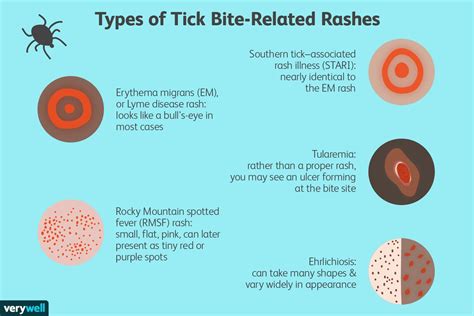Intro
Effective Tick Bite Medicine Treatment options, including antibiotics and antivirals, to combat Lyme disease, Rocky Mountain spotted fever, and other tick-borne illnesses, with prevention tips and natural remedies.
Tick bites can be a significant concern for individuals who spend time outdoors, particularly during the warmer months. These tiny arachnids can transmit a range of diseases, including Lyme disease, Rocky Mountain spotted fever, and Southern tick-associated rash illness (STARI). Understanding the importance of prompt and effective treatment is crucial in preventing long-term health complications. In this article, we will delve into the world of tick bite medicine treatment, exploring the various options available and the best practices for preventing tick-borne illnesses.
The risk of tick-borne diseases is a growing concern, with the number of reported cases increasing steadily over the past few decades. This trend is attributed to a combination of factors, including climate change, urbanization, and the increasing popularity of outdoor activities. As a result, it is essential to take proactive measures to prevent tick bites and to seek medical attention promptly if a bite occurs. The good news is that most tick-borne diseases can be effectively treated with antibiotics, and early intervention can significantly reduce the risk of long-term health complications.
Preventing tick bites is the most effective way to avoid the risk of tick-borne diseases. This can be achieved by taking a few simple precautions, such as wearing protective clothing, applying insect repellents, and conducting regular tick checks. However, even with these precautions in place, tick bites can still occur. If a tick bite is suspected, it is essential to seek medical attention promptly, as early treatment can significantly improve outcomes. In the following sections, we will explore the various aspects of tick bite medicine treatment, including the benefits, working mechanisms, and best practices.
Tick Bite Symptoms and Diagnosis

The symptoms of a tick bite can vary depending on the type of disease transmitted. In general, the initial symptoms may include a red, circular rash, fever, headache, and fatigue. In some cases, the rash may be accompanied by a distinctive "bull's-eye" pattern, which is characteristic of Lyme disease. If left untreated, tick-borne diseases can progress to more severe symptoms, including arthritis, neurological problems, and even life-threatening complications. Diagnosing tick-borne diseases can be challenging, as the symptoms are often non-specific and may resemble those of other conditions. A physical examination, medical history, and laboratory tests, such as blood tests and skin biopsies, may be necessary to confirm the diagnosis.
Treatment Options for Tick Bites

The treatment of tick bites depends on the type of disease transmitted and the severity of the symptoms. In general, antibiotics are the primary treatment for most tick-borne diseases. For example, doxycycline is commonly used to treat Lyme disease, while ceftriaxone may be prescribed for more severe cases. In addition to antibiotics, patients may also require supportive care, such as pain management and hydration. In some cases, hospitalization may be necessary to monitor the patient's condition and provide more intensive treatment.
Antibiotic Treatment for Tick Bites
Antibiotic treatment is the cornerstone of tick bite medicine treatment. The choice of antibiotic depends on the type of disease transmitted and the severity of the symptoms. The most commonly used antibiotics for tick-borne diseases include: * Doxycycline * Ceftriaxone * Amoxicillin * Ciprofloxacin It is essential to note that antibiotic treatment should only be initiated under the guidance of a healthcare professional, as improper use can lead to antibiotic resistance and other complications.Prevention and Control Measures

Preventing tick bites is the most effective way to avoid the risk of tick-borne diseases. The following measures can be taken to reduce the risk of tick bites:
- Wear protective clothing, such as long-sleeved shirts and pants
- Apply insect repellents, such as DEET or picaridin
- Conduct regular tick checks, particularly after spending time outdoors
- Avoid areas with high grass and leaf litter, where ticks are commonly found
- Use permethrin-treated clothing and gear, which can help repel and kill ticks
Tick Removal and Disposal
If a tick bite occurs, it is essential to remove the tick promptly and correctly. The following steps should be taken: 1. Use fine-tipped tweezers to grasp the tick as close to the skin as possible 2. Pull upward with steady, even pressure 3. Avoid twisting or jerking the tick, which can cause the mouthparts to break off and remain in the skin 4. Clean the bite area with soap and water 5. Dispose of the tick by placing it in a sealed bag or containerComplications and Long-Term Effects

If left untreated, tick-borne diseases can lead to a range of complications and long-term effects. These may include:
- Arthritis and joint pain
- Neurological problems, such as meningitis and encephalitis
- Heart problems, such as abnormal heart rhythms
- Respiratory problems, such as pneumonia It is essential to seek medical attention promptly if a tick bite occurs, as early treatment can significantly reduce the risk of long-term complications.
Post-Treatment Care and Follow-Up
After completing treatment for a tick-borne disease, it is essential to follow up with a healthcare professional to ensure that the infection has been fully cleared. This may involve: * Follow-up blood tests to monitor for any remaining infection * Physical examinations to assess for any signs of complications * Ongoing monitoring for any signs of long-term effects, such as arthritis or neurological problemsConclusion and Future Directions

In conclusion, tick bite medicine treatment is a complex and multifaceted field that requires a comprehensive approach to prevention, diagnosis, and treatment. By understanding the risks and consequences of tick-borne diseases, individuals can take proactive measures to prevent tick bites and seek medical attention promptly if a bite occurs. Ongoing research and development are focused on improving our understanding of tick-borne diseases and developing more effective treatments and prevention strategies.
As we move forward, it is essential to prioritize education and awareness about the risks of tick-borne diseases and the importance of prompt treatment. By working together, we can reduce the burden of these diseases and improve outcomes for individuals affected.
What are the most common symptoms of a tick bite?
+The most common symptoms of a tick bite include a red, circular rash, fever, headache, and fatigue. In some cases, the rash may be accompanied by a distinctive "bull's-eye" pattern, which is characteristic of Lyme disease.
How can I prevent tick bites?
+Preventing tick bites can be achieved by taking a few simple precautions, such as wearing protective clothing, applying insect repellents, and conducting regular tick checks. Additionally, avoiding areas with high grass and leaf litter, where ticks are commonly found, can also reduce the risk of tick bites.
What is the best way to remove a tick?
+The best way to remove a tick is to use fine-tipped tweezers to grasp the tick as close to the skin as possible and pull upward with steady, even pressure. Avoid twisting or jerking the tick, which can cause the mouthparts to break off and remain in the skin.
Can tick-borne diseases be prevented with vaccines?
+Currently, there are no vaccines available to prevent most tick-borne diseases. However, researchers are working to develop vaccines against certain tick-borne diseases, such as Lyme disease.
How long does it take to recover from a tick-borne disease?
+The recovery time from a tick-borne disease can vary depending on the type of disease and the severity of the symptoms. In general, most individuals can recover from tick-borne diseases with prompt treatment, but some may experience long-term effects, such as arthritis or neurological problems.
We hope this article has provided you with a comprehensive understanding of tick bite medicine treatment and the importance of prevention and prompt treatment. If you have any further questions or concerns, please do not hesitate to reach out to a healthcare professional. Additionally, we invite you to share your thoughts and experiences with tick-borne diseases in the comments section below. By working together, we can raise awareness and reduce the burden of these diseases.
